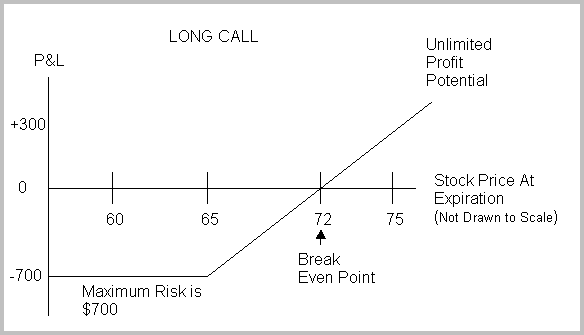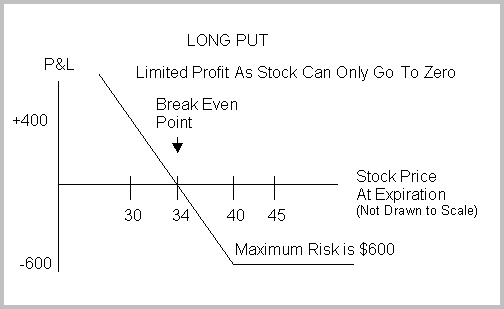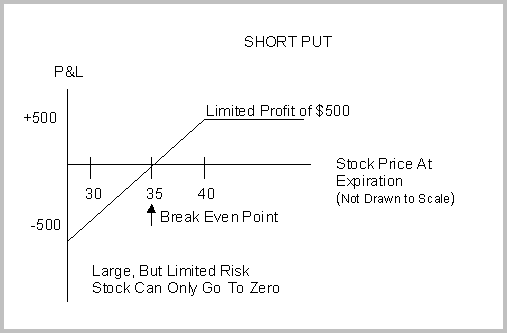Basic Options Trading Strategy
Options are among the most versatile of financial instruments. They can be used for speculation or hedging. Conservative or aggressive, there s a strategy for you. Options can be used alone, in conjunction with stocks you already own, or even with other options. When trading options, you need to understand and be aware of the risk and reward characteristics and breakeven points of each option strategy. We will be examining the profit and loss scenarios at option expiration. Keep in mind that it is possible to close the position before expiration. To close your position, simply reverse what you did. If you bought, then sell. If you sold, then buy back. The basic option strategies we’ll be looking at are:
Long Call Buying call options.
Long Put Buying put options.
Short Call Selling call options.
Short Put Selling put options.
Covered Call/Covered Write Selling call options on stocks you own.
Click here to learn how to utilize Bollinger Bands with a quantified, structured approach to increase your trading edges and secure greater gains with Trading with Bollinger Bands® – A Quantified Guide.
Long Call
The long call or call buying strategy is among the most basic, yet most profitable option strategies. It simply involves the purchase of call options. The long call strategy offers the trader unlimited profit potential and limited downside risk. The long call is the most bullish of option strategies as there generally is a high amount of leverage involved. So if you think that a stock is going up, buy calls. For instance, let’s say that you like EMC Corporation
(
EMC |
Quote |
Chart |
News |
PowerRating). It’s currently at $65, and you think that it’s going to move up. You could buy one February 65 call at 7 or $700. The amount of the premium, or $700, is the most that you can lose. It doesn t matter if the stock goes to zero; the most you can ever lose in buying calls is the amount of the premium paid. At expiration, in order to profit from this transaction, EMC must be above your breakeven price of 72. To find the breakeven price, simply add the strike price of the option to the premium of the option. The breakeven point for long calls is calculated as:
Strike Price + Option Premium = Breakeven Price For Long Calls
In this case, our breakeven price is calculated as 65 + 7 = 72. This is the price that EMC must be above at expiration for us to profit from this transaction. At expiration, there are three possible scenarios. First, the stock price could be above the strike price. For instance, say EMC is at 75, which is 10 points above our strike price of 65. Our option would be 10 points in-the-money and should be worth at least 10. This is great for us since we bought the option at 7 and we could now sell it for 10. As an alternative to selling our call, we could exercise our option to purchase 100 shares of EMC at $65 and then turn around and sell it at 75. Most traders opt to sell their option instead of exercising it. Our profit in either case would be 42.8% while the stock moved only 15.4%.
Second, the stock price could be equal to the strike price. At expiration, let’s say that EMC was at 65; at this price you probably would not exercise your option to buy the stock for 65 while it’s already trading on the open market for 65. Recall that we paid 7 for the option. If we did use our option to buy 100 shares of EMC at 65, we would really be paying 72 (65 + 7) per share for the stock.
Lastly, the stock price could be below the strike price. Let’s say at expiration, instead of moving up, EMC drops to 55. In this case, no one in their right mind would exercise their option to buy EMC at 65 while it’s trading at 55. In this case, our option would be worthless, and we would lose $700, or 100% of our money.

Long Put
The long put or put buying is a bearish strategy that traders use to profit from a down move in a stock. Put buying also has limited risk and a large, but limited reward. The reward is limited because a stock can only go down to zero. Put buying is the most bearish of option strategies. If you think a stock is going down, buy puts. For example, if you think that Cisco Systems
(
CSCO |
Quote |
Chart |
News |
PowerRating) is going to move down, you could buy a put on Cisco. If Cisco is currently trading at 36, and you decide to buy a Cisco February 40 put for $6 or $600, then you bought the right to sell 100 shares of Cisco stock at 40 per share. The breakeven point for the long put is calculated as:
Strike Price Put Price = Breakeven For Puts
Our breakeven point in this case would be 34 (40-6=34). We would not profit from this transaction until the stock goes lower than 34. Again there are three possible scenarios at expiration. First, the stock could be above the strike price. In this case, let’s say Cisco is at 50; your put with a strike price of 40 would be ten points out-of-the-money. Since no one would exercise their option to sell Cisco at 40, your option would be worthless and you would lose $600 or 100%.
Second, the stock could equal the strike price. Let’s say that at expiration, Cisco is trading at 40. The put option would also be worthless because no one would buy it to sell the stock at 40 while it’s already trading at 40. You would not exercise your option because then you would be essentially selling at 34.
Lastly, the stock could be below the strike price. If at expiration, Cisco were at $30, your put option would be worth at least $10. In this case you would make $400 or a 66% return.

Short Call
Now let’s take a look at the short call or call selling. The short call strategy involves selling call options on stock that you don t own. Remember that the buyer of the call has the right to buy so that means that you have the obligation to sell. Call selling is a neutral strategy, in which you don t want the stock to move much either way. The reward is limited to the premium received, but your risk is unlimited. The stock could shoot up significantly, thus forcing you to buy the stock at a high price so that you can meet your obligation to sell it at a lower price.
Let’s look at an example. Say that you think Dell Computer
(
DELL |
Quote |
Chart |
News |
PowerRating) is likely to stay neutral. With the stock at 21, you could sell a February 25 call for 1, or $100. That $100 is your maximum profit. To calculate the breakeven point for a call sell, add the strike price of the option to the price of the premium received. The breakeven would be calculated as:
Strike Price + Premium = Breakeven For Call Sell
Our breakeven price in this case would be 25 + 1 = 26. If the stock goes to 26, you would lose the $100 profit. Once again, there are three possible scenarios at expiration. First, the stock price could be above the strike price. If the stock rallies to 30, you would have been called out or forced to sell the stock at 25, but since you don t own the stock, you would have to buy it on the open market at 30 and sell it at 25. Since you lose $500 in the stock transaction, but got paid $100 for selling the call, you would end up losing $400.
Second, the stock price could be the same as the strike price. If the stock ended up at 25, it is most likely that the holder/buyer of the option would not exercise the option. Therefore, you would keep the $100.
Lastly, the stock could be below the strike price. Let’s say that the stock ended up at 18, in which case you would keep the premium because no one is going to exercise their call option to buy the stock at 25 while it’s trading at 18. Selling options on stock that you don t already own is known as going naked. Selling naked options is a very dangerous strategy. If the stock takes off to 50, you would have to deliver or sell the stock to the call buyer at 25 and face a $2500 loss. Of course, you could always buy back the option that you sold, thus canceling your obligation to sell the stock.

Short Put
The short put or put selling strategy is a bullish strategy. Remember that the put buyer has the right to sell the stock, so the put seller has the obligation to buy the stock at the strike price, if the put buyer chooses to exercise. Put selling has a limited reward and a large, but limited risk; the stock can only go to zero. In this strategy, you want the stock to keep moving up so that the put buyer would not exercise their option, and therefore, you get to keep the premium. The breakeven point for put selling is calculated by subtracting the put premium from the strike price. For example:
Strike Price Put Premium = Breakeven For Put Sell
Let’s say that you re bullish on Cisco Systems (CSCO). With the stock at 35, you decide to sell a February 40 put for 5 or $500. The $500 is your maximum profit. Breakeven is calculated to be 35 (40-5). At the breakeven price of 35, the put buyer would exercise the option, and we would be forced to buy the shares at 40, but since we received 5 for selling the put, we are really buying the stock at 35, which is also the current market price. So in this case, we would essentially be at breakeven. At expiration, there are three likely scenarios. First, the stock could be above the strike price. At expiration, with Cisco at 50, put buyers would not exercise their option to sell Cisco at 40 while it’s trading at 50. The February 40 put would be worthless, and we would keep the premium.
Second, the stock could equal the strike price. In this case, the put buyer would most likely not exercise the option and we would also keep the premium. Lastly, the stock could be under the strike price. Let’s say that at expiration, Cisco is at 30, the put buyer would definitely exercise their option to sell the stock at 40. We would be obligated to buy 100 shares of Cisco at 40 while it’s trading at 30. Since we were paid 5, or $500, for selling the put, we would really be buying Cisco at 35 while it’s trading at 30, therefore we re faced with a $500 loss. From 1997 to 1999, Dell Computer Corporation sold puts on their own stock and made over $97 million in the process. Though now with their stock price sitting at a three-year low, their put selling activities could cost the company a potential $3.4 billion in loses (Business Week, 1/15/01).

Covered Call
Our final strategy, the covered call or covered write, is essentially the same as the short call, except that in this case, we own the underlying stock. In this strategy, we sell call options on stock that we already own. What happens is that we are putting a cap on how high the stock can move. We are also receiving a little protection on our downside risk. Covered call writing is a popular strategy used to generate extra income from stocks in narrow-range markets. Our breakeven on this strategy would be calculated as:
Stock Price (purchase price of stock) Call Price = Breakeven For Covered Call
32 – 3 = 29
For instance, say we bought 100 shares of Sun Microsystems at 32 and sold a February 35 call for 3 or $300. Our breakeven point would be at 29 (32-3). At expiration, there are three possible scenarios. First, the stock price could be trading above the strike price. If Sun was trading at 45 at expiration, we would not be able to sell our shares at 45 since we sold a February 35 call against our stock. We would therefore be called out of our shares at 35, but since we received 3 for the option, we are really selling our stock at 38. In this case, we missed out on any further upside potential past our strike price.
Second, the stock price could equal the strike price. In this case, if at expiration Sun is at 35, the call buyer would not exercise the call, and therefore, we keep the premium. Lastly, the stock price could be below the strike price. If at expiration, Sun is at 25, no one would use their option to buy the stock at 35, the option would expire worthless and we get to keep the premium. Keep in mind that we bought the stock at 32, so we are down 7 points, but since we sold a call for 3, we are really down 4 points. The covered call in this case gave us a little downside protection. The covered call or covered write is a very popular strategy among conservative traders and it is usually the first option strategy that traders utilize.
Conclusion/Recap
As we have seen, options are leveraged financial instruments that offer traders versatility and the potential for spectacular profits. Most novice traders use the basic long call or long put strategy to take advantage of the unlimited-profit and limited-risk characteristics. Although it’s possible to make incredible profits by utilizing the long call or put strategies, traders must realize that they have the odds stacked against them.
it’s no easy feat to consistently win and win big by solely utilizing the long call or put strategy. The Four Horsemen are standing in your way, and you must defeat them before you can claim your profits. Yes, it’s true that your risk is limited to the premium paid for the option, but that is still 100% of your investment! How many times have you jumped at the chance to risk it all?
If you re still inclined to use options for these boom or bust bets, then be my guest. Just be sure to have an exit strategy in mind so that you don t lose 100% every time. According to most options experts, option buyers are suckers in the long run as roughly half of all options expire worthless.
I hope you have learned something from this lesson, or at least had your interest in options sparked.
Vincent Mao was an Editor at TradingMarkets.com from 2001-2003 and 2004-2005.
You can find more how-to and educational articles to improve your investing and trading each day on TradingMarkets.com.
